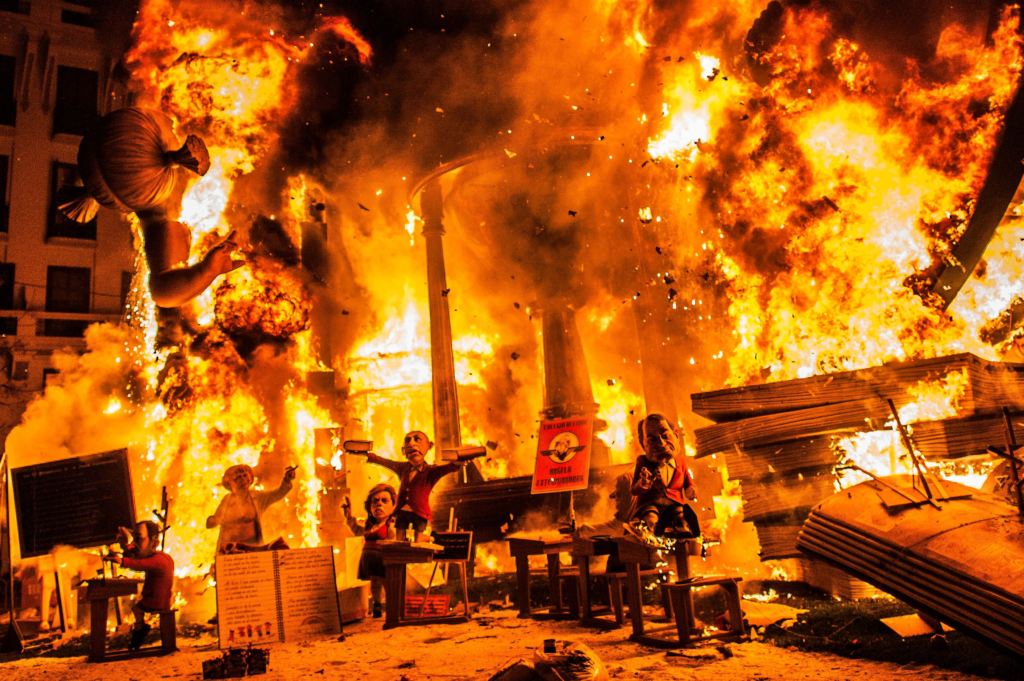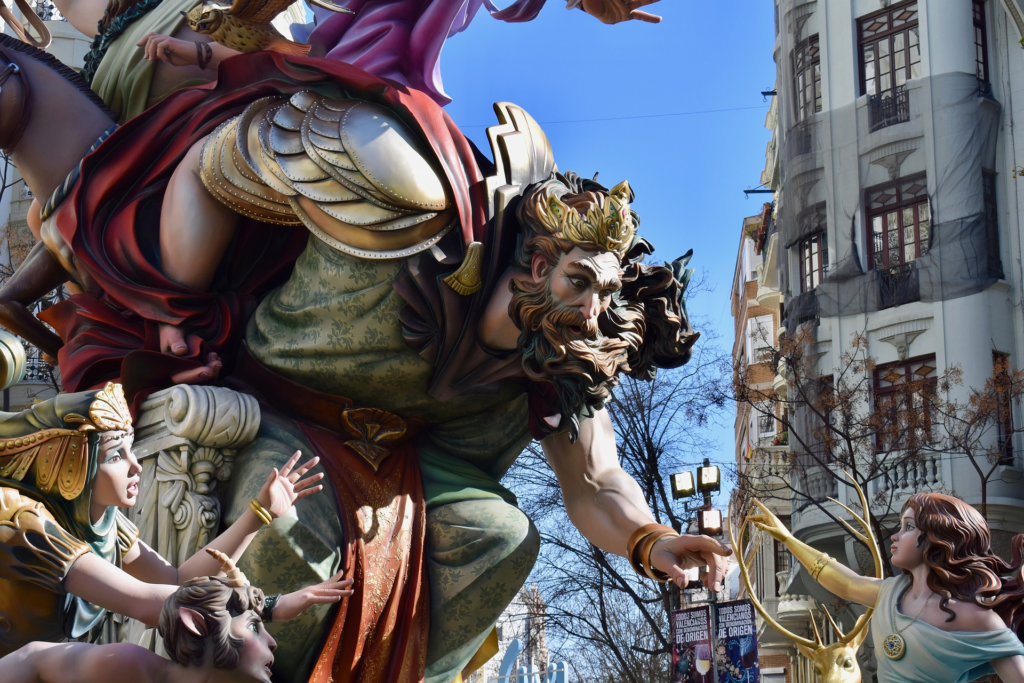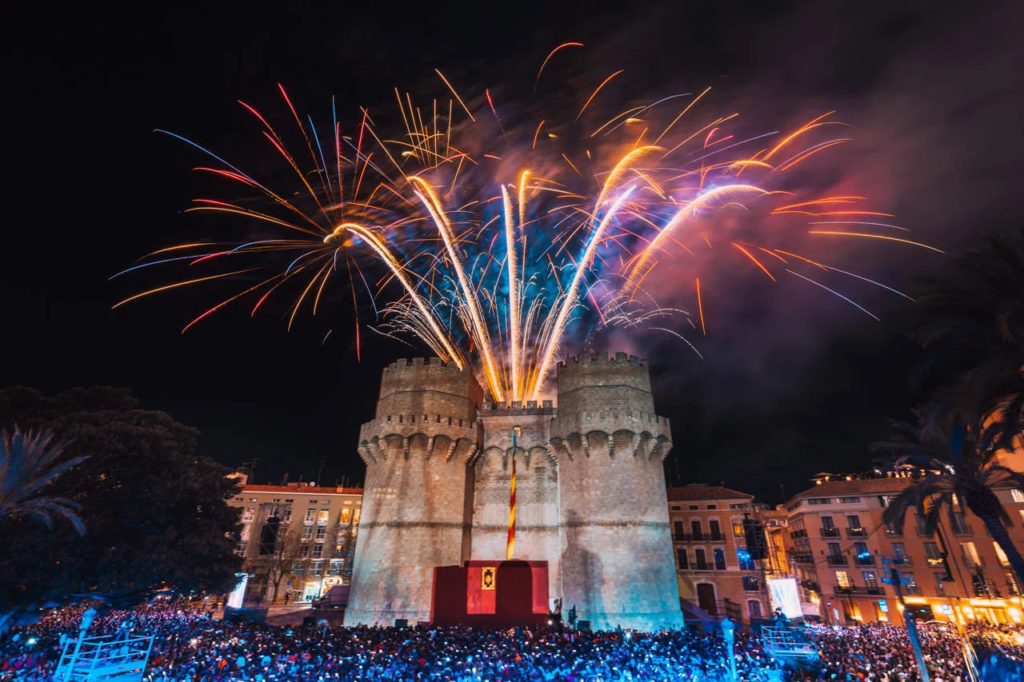Las Fallas Festival, one of Spain’s most famous and vibrant festivals, takes place every March in Valencia, turning the city into a spectacular celebration of fire, art, and culture. It is a festival where creativity meets tradition, and where art is created only to be destroyed in the most magnificent way possible. Declared a UNESCO Intangible Cultural Heritage of Humanity in 2016, Las Fallas attracts over a million visitors annually, making it one of Spain’s largest and most exciting events. This article will explore everything you need to know about Las Fallas, from its history and meaning to its traditions, key events, and tips on how to experience it.
The Origins of Las Fallas Festival

The origins of Las Fallas Festival date back to ancient times when carpenters in Valencia would celebrate the arrival of spring by burning old wood and materials they no longer needed. This ritual coincided with Saint Joseph’s Day, the patron saint of carpenters, on March 19th. Over time, these simple bonfires evolved into a more elaborate celebration. People began crafting figures, or “ninots,” out of wood and other materials to burn in the fires. What began as a humble tradition slowly grew into the grand spectacle that it is today.
By the late 19th century, these ninots had taken on a life of their own, becoming large and detailed sculptures that often represented satirical themes, mocking politicians, celebrities, and social issues. These intricate creations are now made of papier-mâché, wood, and cardboard and can reach heights of 20 meters or more. Despite the artistry and labor involved, all but one ninot per year is destined to be burned in the final fiery climax of the festival.
Keep reading: Digital Nomad Visa for Spain: Everything You Need to Know
Key Events of Las Fallas Festival

Las Fallas Festival officially begins on March 1st, but the real action picks up in the final week leading up to March 19th. Here are the main events that you should not miss:
- La Mascletà (March 1st – 19th):
Every day at 2:00 PM in Plaza del Ayuntamiento, the city hosts a mascletà, a pyrotechnic event unique to Valencia. Unlike typical fireworks displays, the mascletà is more about the sound than the visuals. Hundreds of firecrackers and rockets are set off in a synchronized, deafening explosion, creating a rhythm that builds to a dramatic crescendo. It’s an intense experience that draws thousands of spectators daily. The sound levels can reach up to 120 decibels, so earplugs are recommended! - La Plantà (March 15th):
This is the day when the fallas (large sculptural installations) are completed and officially placed around the city. Over 700 fallas are set up, each one more intricate and creative than the last. The artists work tirelessly for months to create these incredible works of art, knowing that in just a few days, they will be reduced to ashes. - La Ofrenda (March 17th – 18th):
One of the most emotional and beautiful events of Las Fallas is the offering of flowers to the Virgen de los Desamparados, the patron saint of Valencia. Over two days, thousands of falleros and falleras, dressed in traditional Valencian costumes, walk in a parade to the Plaza de la Virgen, carrying flowers that are used to create a massive floral tapestry. This event is a beautiful blend of devotion and artistry. - La Nit del Foc (Night of Fire, March 18th):
The night before the grand finale, Valencia lights up the sky with one of the most impressive firework displays in the world. The Nit del Foc is a dazzling spectacle that lasts well into the night, drawing huge crowds to the Turia Gardens to witness the colorful explosion of light and sound. - La Cremà (March 19th):
This is the moment everyone waits for: the burning of the fallas. Starting at around 10:00 PM, the smaller fallas, known as falletas, are set alight, followed by the larger ones at midnight. The grand finale happens at Plaza del Ayuntamiento, where the most impressive falla is burned amid fireworks and cheering crowds. Watching the fallas go up in flames is both a celebration and a bittersweet farewell to the festival’s ephemeral beauty. - Ninot Indultat (March 19th):
While most of the ninots are burned, each year one ninot is spared from the flames by popular vote. This “indulted” ninot is placed in the Fallas Museum, where it can be admired for years to come. It’s a significant honor for the artist whose creation is saved.
Cost of Experiencing Las Fallas

Attending Las Fallas Festival can be as budget-friendly or as extravagant as you want, depending on your preferences. Here’s a breakdown of some typical costs:
- Accommodation: Since Las Fallas Festival attracts massive crowds, hotel prices in Valencia can increase significantly during the festival. If you plan to stay in the city center, expect to pay between €100 to €300 per night for a mid-range hotel. For budget travelers, hostels or Airbnb options start around €50 to €80 per night, but these should be booked months in advance to secure a good rate.
- Meals: Dining out in Valencia during Las Fallas Festival can vary depending on where you eat. A meal at a typical restaurant will cost between €15 to €30 per person. For a more local experience, you can try street food at one of the many stalls set up for the festival. Popular choices include paella, churros, and buñuelos (fried dough balls), with prices ranging from €2 to €10.
- Fireworks Displays and Mascletàs: All of the fireworks displays and the daily mascletàs are free to attend. However, if you want a prime viewing spot for events like La Nit del Foc or La Cremà, it’s a good idea to arrive early, as these events attract huge crowds.
- Falla Museum: To visit Las Fallas Festival Museum, where you can see the ninots saved from the flames, tickets cost around €2 to €4 per person.
Interesting Facts and Statistics

- Number Las Fallas Festival: There are usually more than 700 fallas created and displayed throughout the city during the festival. These fallas can cost anywhere from €10,000 to over €100,000 to construct, depending on their size and complexity.
- Attendance: The festival draws more than 1 million visitors each year, both from Spain and internationally. The streets of Valencia are packed with locals and tourists alike, all eager to take part in the festivities.
- Fireworks Budget: The city of Valencia spends around €8 million on fireworks and pyrotechnics alone during Las Fallas. Each mascletà and firework display is a carefully planned spectacle, with each night offering something more impressive than the last.
- Economic Impact: Las Fallas Festival generates an estimated €60 million for Valencia’s economy each year. This includes spending on accommodation, dining, transportation, and souvenirs.
Tips for Enjoying Las Fallas Festival

- Plan Your Accommodation Early: As mentioned earlier, Valencia’s hotels fill up quickly for Las Fallas Festival, so it’s essential to book your accommodation months in advance. If you can’t find something within the city, consider staying in nearby towns like Gandía or Sagunto and taking a short train ride into Valencia.
- Be Prepared for Crowds: Las Fallas is a popular festival, and the streets of Valencia are packed day and night. While this adds to the festive atmosphere, it’s essential to be patient and give yourself extra time to get around. If you’re planning to visit specific fallas or events, arrive early to secure a good spot.
- Ear Protection for Mascletàs: The mascletàs are incredibly loud, with decibel levels that can rival a jet engine. It’s a good idea to bring earplugs, especially if you’re sensitive to noise. Despite the intense sound, the mascletà is a unique experience that you shouldn’t miss.
- Learn the Local Customs: During Las Fallas, it’s common to see locals, especially children, setting off firecrackers in the streets. While this can be a bit startling, it’s all part of the fun. Just be aware of your surroundings, especially in crowded areas, and stay safe.
- Wear Comfortable Shoes: You’ll be doing a lot of walking during Las Fallas, as the fallas are spread throughout the city. Comfortable footwear is essential, as you’ll be on your feet for hours exploring Valencia’s streets, plazas, and events.
- Dress for the Weather: March in Valencia is generally mild, with temperatures ranging from 10°C to 20°C (50°F to 68°F). However, nights can get chilly, so it’s a good idea to bring layers, especially if you plan on staying out late for events like La Nit del Foc and La Cremà.
Read more: 10 Days in Spain: A Full Detailed Planing










